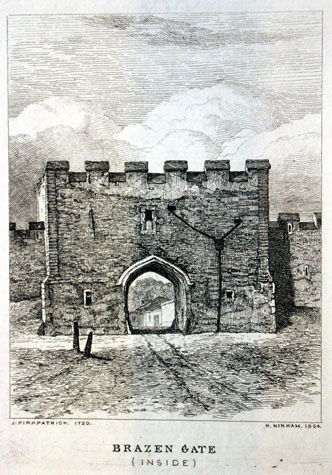|

[1] The gate from the east from inside the city.
By H Ninham from an early 18th-century drawing by John
Kirkpatrick. [Norwich Castle Museum and
Art Gallery 1954.138, Todd 5, Norwich 118b]
|
Introduction
Brazen Doors were at the west end of the street that is
now called All Saints Green. [1] The date of their construction
is uncertain. A Customs Book from the reign of Edward III,
cited by Robert Fitch, simply records 307 battlements between
Ber Street Gate and St Stephen's and adds 'here were
some strong towers'. As all the other gates are listed,
the implication by omission is that at that time there was no
gate between Ber Street and St Stephens. Though Fitch does
not specifically give a date for the document, the inference
is that it was 1345.
[Fitch, page x] However, in
a document from 1320 or 1321 (13th year of the reign of
Edward I) John de Bate and his son Thomas were granted a barn
by Martin Ordiner. This was described as being between the
lands of Peter the Clerk and those of Ralph de Ely, by the
gates of Swinemarket in the parish of St Stephen. Perhaps the
gateway was adapted from an intermediate tower.
The gateway was very narrow and was really a postern. It
was known variously as the Iron Door(s), Gates of Swinemarket,
and New Gate. [Fitch, page 9]
The gate, or perhaps more specifically the gate arch was
rebuilt in 1726, when it was made wide enough for coaches
and carts to pass through.
[Tonnage Books, N.R.O. NCR Case 19 Shelf C; Fitch, page 10]
It then became known as New Gate. [Blomefield, page 442; SMR NF26016]
Blyth noted in 1842 that these were the last of the gates
to be erected, and that it was originally a postern, but that
'subsequently a red brick building, embattled, with a wide
arch, and chamber over it, occupied the place of the old
postern'.
[Blyth, page 4]
The gate was removed in 1792.
[Fitch, page 10]
|
